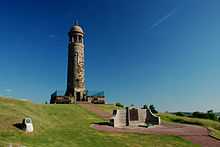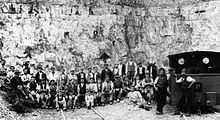Crich
| Crich | |
 Bowns Hill, Crich |
|
 Crich | |
| Population | 2,821 (2001 census)[1] |
|---|---|
| OS grid reference | SK3454 |
| Civil parish | Crich |
| District | Amber Valley |
| Shire county | Derbyshire |
| Region | East Midlands |
| Country | England |
| Sovereign state | United Kingdom |
| Post town | Matlock |
| Postcode district | DE4 |
| Dialling code | 01773 |
| Police | Derbyshire |
| Fire | Derbyshire |
| Ambulance | East Midlands |
| EU Parliament | East Midlands |
| UK Parliament | Derbyshire Dales |
| Website | Crichweb |
| |
 |
Pronounced
(listen)
|
| Problems playing this file? See media help. | |
Crich /ˈkraɪtʃ/ is a village in Derbyshire in England. It has the National Tramway Museum inside the Crich Tramway Village, and at the summit of Crich Hill above, a Memorial Tower for those of the Sherwood Foresters regiment who died in battle, particularly in World War I.
Built in 1923 on the site of an older tower called Crich Stand, the Memorial Tower is the destination of an annual pilgrimage on the first Sunday in July. It is 1,000 feet (300 m) above sea level, and has 52 steps to the top. From there eight counties can be seen, including landmarks such as the Humber Bridge and Lincoln Cathedral.[2]
History
In 1009 King Æthelred the Unready signed a charter at the Great Council which recognised the position and boundaries of Weston-on-Trent and several other manors including Crich.[3] The charter shows that Weston controlled the nearby crossings of the Trent. The land was listed as eight hides at Weston upon Trent, and a hide at Crich, Morley, Smalley, Ingleby and Kidsley. This land was then given to Morcar, the King's chief minister, and he was unusually given rights that were normally reserved for the King alone. He was given the responsibility for justice and exemption from the Trinoda necessitas, he alone could decide a fate of life or death without the need of the authority of the King or his sheriff.[3] Morcar was given further lands in Derbyshire. Weston (and Crich?) again come under the control of Æþelræd Unræd, when Morcar and his brother were murdered by Eadric in 1015.
Parts of the Church of England parish church of Saint Mary are Norman, with later Decorated Gothic and Perpendicular Gothic alterations from the 14th century.[4] Crich has also a Wesleyan Chapel that was built in 1770.[5]
A workhouse was opened in 1734 on the edge of Nether Common. It could accommodate 40 inmates, and accepted paupers from other parishes, including Melbourne, Pentrich, Willington, Mercaston and Denby.[6]
Chase Cliffe is a Tudor Revival house on the road from Crich to Whatstandwell.[5] It was designed by Benjamin Ferrey and built in 1859–61.[5]
Crich was the setting for the ITV drama series Peak Practice (along with Ashover for a time). Crich is home to 'The Briars', a residential youth centre for the Catholic Diocese of Nottingham. It hosts approximately 5000 young people a year from across the East Midlands, working with them on personal, social and spiritual themes. Images of the village also appear in the 2007 film And When Did You Last See Your Father? starring Colin Firth. In the film Firth is seen riding a motorbike up Chapel Lane.
Quarrying

Geologically, Crich lies on a small inlier of Carboniferous limestone (an outcrop on the edge of the Peak District surrounded by younger Upper Carboniferous rocks).
Quarrying for limestone probably began in Roman times. In 1791 Benjamin Outram and Samuel Beresford bought land for a quarry to supply limestone to their new ironworks at Butterley. This became known as Hilt's Quarry, and the stone was transported down a steep wagonway, the Butterley Company Gangroad, to the Cromford Canal at Bullbridge. Near there they also built lime kilns for supplying farmers and for the increasing amount of building work. Apart from a period when it was leased to Albert Banks, the quarry and kilns were operated by the Butterley Company until 1933.[7]

The gangroad, descending some 300 feet in about a mile, was at first worked by gravity, a brakeman "spragging" the wheels of the wagons, which were returned to the summit by horses. However, in 1812 the incline was the scene of a remarkable experiment, when William Brunton, an engineer for the company, produced his Steam Horse locomotive.
In 1840 George Stephenson, in building the North Midland Railway, discovered deposits of coal at Clay Cross and formed what later became the Clay Cross Company. He realised that burning lime would provide a use for the coal slack that would otherwise go to waste. He leased Cliff Quarry and built limekilns at Bullbridge. They were connected by another wagonway including a section known as "The Steep", a 550 yards (500 m) self-acting incline at a slope of 1 in 5.
Cliff Quarry closed in 1957, although a small amount of limestone extraction still occurs at the western end; it was bought by the Tramway Museum in 1959.
Hilt's Quarry closed in 1933 and is derelict. For 38 years, Rolls-Royce used it for dumping low-level radioactive waste such as enriched uranium, cobalt-60 and carbon-14. Following a campaign and blockades by villagers in the Crich and District Environment Action Group, dumping ceased in 2002. In 2004 the Government backed an Environment Agency document banning further dumping, and Rolls-Royce will be required to restore and landscape the site.[8][9][10]
See also
References
- ↑ "Area selected: Amber Valley (Non-Metropolitan District)". Neighbourhood Statistics: Full Dataset View. Office for National Statistics. Retrieved 29 September 2011.
- ↑ Crich Memorial, official site
- ↑ 3.0 3.1 Charter of Æthelred, The Great Council, 1009, accessible at Derby records
- ↑ Pevsner & Williamson, 1978, page 156
- ↑ 5.0 5.1 5.2 Pevsner & Williamson, 1978, page 157
- ↑ Higginbotham, P. (2007), Workhouses of the Midlands, Tempus, Stroud. Page 27. ISBN 978-0-7524-4488-8
- ↑ Cooper, B., (1983) Transformation of a Valley: The Derbyshire Derwent, Heinneman, republished 1991 Cromford: Scarthin Books
- ↑ "End to Nuclear Dumping" Belper News
- ↑ "Final victory for campaign", Emily Davies, Matlock Mercury, 30 June 2004
- ↑ Eco Sounding, Paul Brown, The Guardian, August 4, 2004
Sources
- Pevsner, Nikolaus; Williamson, Elizabeth (1978) [1953]. Derbyshire. The Buildings of England. Harmondsworth: Penguin Books. pp. 156–157. ISBN 0-14-071008-6.
External links
- The website of Crich Baptist Church
- Crich Village Website
- Crich area community news website
- Official site for the Crich Memorial
- Crich news from the Derby Telegraph
| Wikimedia Commons has media related to Crich. |